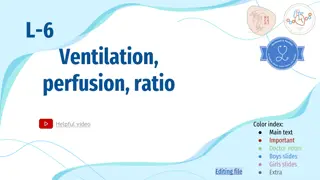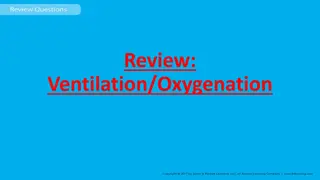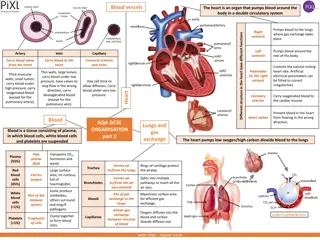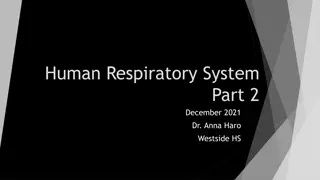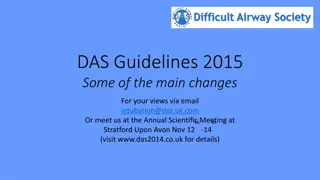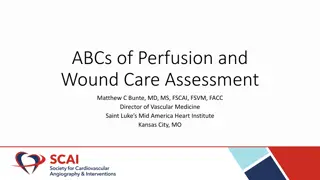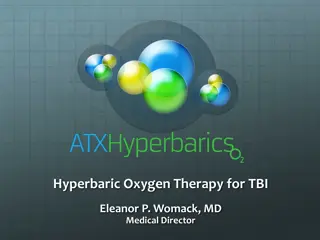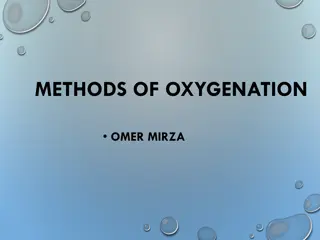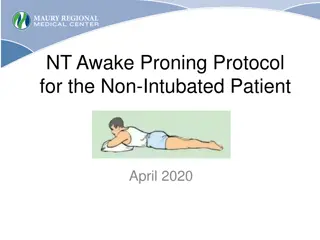Understanding Pulmonary Circulation and V/Q Ratio in Respiratory Physiology
Explore the high-pressure and low-pressure circulations supplying the lungs, the concept of physiological shunt in pulmonary circulation, different lung zones based on blood flow, V/Q ratio and its clinical significance, and abnormal V/Q ratio patterns. Delve into the role of pulmonary circulations
11 views • 28 slides
Understanding Ventilation and Oxygenation in Respiratory Care
Review covers key concepts of ventilation and oxygenation, including the control of breathing, assessment of tidal volume, and the roles of different respiratory centers. Learn about the importance of observing chest rise to assess tidal volume accurately. Gain insights into the brain stem's pivotal
6 views • 41 slides
Exploring the Components of the Circulatory System
The circulatory system, comprising the heart, blood vessels, and various components like arteries, veins, and capillaries, plays a crucial role in distributing oxygen, nutrients, and waste products throughout the body. The heart pumps blood through a double circulatory system, ensuring oxygenation o
0 views • 4 slides
Understanding the Human Respiratory System: Anatomy, Functions, and Importance
The human respiratory system plays a vital role in gas exchange and maintaining overall health. This article delves into the anatomy of the respiratory system, its main functions, such as gas exchange and air filtration, and the importance of respiratory health. Learn about the different components,
0 views • 13 slides
Rehabilitation Considerations During the COVID-19 Outbreak
Rehabilitation services during the COVID-19 pandemic are crucial for continuing essential care and optimizing outcomes, especially for individuals with severe COVID-19 cases. Considerations for non-COVID-19 rehabilitation services must be maintained to address acute injuries, post-surgical recovery,
0 views • 14 slides
Comprehensive Overview of High-Flow Nasal Cannula (HFNC) Systems
High-Flow Nasal Cannula (HFNC) systems, defined as a system providing heated and humidified oxygen at high flow rates, have various applications in healthcare settings including rural hospitals. This presentation covers the definition, indications, contraindications, complications, setup, and use of
0 views • 11 slides
Updates on DAS Guidelines 2015: Key Changes and Recommendations
Revised DAS Guidelines 2015 introduce significant updates for airway management. Changes include rebranding of plan elements, emphasis on oxygenation maintenance, use of videolaryngoscopes, and considerations for various airway scenarios. Specific modifications address techniques such as rapid seque
0 views • 7 slides
Comprehensive Treatment Guidelines for Acute Ischemic Stroke
In the management of acute ischemic stroke, the primary goals are to reduce secondary brain damage, maintain adequate perfusion, and prevent recurrent strokes by managing risk factors. Treatment includes maintaining tissue oxygenation, correcting volume status and electrolytes, managing blood glucos
0 views • 20 slides
Treatment Strategies for Hemorrhagic Stroke: Goals and Management
Short-term goals for treating hemorrhagic stroke involve rapid neurointensive care to maintain adequate oxygenation, breathing, and circulation, along with managing increased intracranial pressure and blood pressure. Long-term management focuses on preventing complications, recurrent bleeding, delay
11 views • 9 slides
Understanding Perfusion and Wound Care Assessment
This comprehensive presentation delves into the critical aspects of perfusion and wound care assessment, covering topics such as tissue oxygenation, measuring tissue perfusion, diagnostic testing for critical limb ischemia, and techniques like ankle and toe systolic pressure measurement and transcut
0 views • 19 slides
Understanding Oxygenation and Respiratory System Function
Explore essential terms like alveoli, perfusion, atelectasis, and more in the context of respiratory system function. Learn about lung anatomy, oxygenation processes, and common respiratory disorders like dyspnea and hypoxia. Discover the crucial factors for maintaining normal respiratory function.
0 views • 35 slides
Understanding Haemodynamic Consequences of Acute Pulmonary Embolism
Haemodynamic consequences of acute pulmonary embolism (PE) include increased mean pulmonary artery pressure, rise in right ventricular preload and end-diastolic pressure, risk of right ventricular failure, and decreased pulmonary blood flow leading to low systolic blood pressure. Arterial hypoxia ca
0 views • 18 slides
Oxygen Therapy in Emergency Medicine
Oxygen therapy is crucial in emergency medicine for treating hypoxemia and improving oxygenation levels in patients. It is essential for conditions like acute hypoxemia, carbon monoxide poisoning, and shock. Various oxygen delivery devices are used to administer oxygen effectively, such as nasal pro
0 views • 27 slides
Hyperbaric Oxygen Therapy for Traumatic Brain Injury (TBI) - Benefits and Mechanisms Explained
Hyperbaric Oxygen Therapy (HBOT) is a cutting-edge treatment that involves providing oxygen in a pressurized environment to enhance oxygenation of body tissues beyond what red blood cells can deliver. This therapy, administered under controlled conditions, offers various physiological and cellular b
0 views • 15 slides
Comprehensive Guide to Oxygenation in Respiratory Care
Oxygenation is a vital aspect of medical care, involving the process of delivering oxygen to the body's cells. It includes measures such as Arterial Oxygen Saturation, Oxygen Delivery, Oxygen Consumption, and Oxygen Extraction. Understanding hypoxia and hypoxemia, as well as the mechanisms of hypoxe
0 views • 28 slides
NT Awake Proning Protocol for Non-Intubated Patients
This protocol outlines the benefits and procedure for prone positioning in non-intubated patients experiencing mild to moderate hypoxemia. It highlights patient eligibility criteria, equipment required, and considerations for nursing care. The protocol emphasizes improving oxygenation by promoting a
0 views • 11 slides
Awake Proning Protocol for Non-Intubated Patients
Learn about the benefits, eligibility, contraindications, equipment needed, and protocol for awake proning in non-intubated patients. Discover how this positioning technique can improve oxygenation and patient outcomes during respiratory illnesses. Eligible patients include those with COVID-19, resp
0 views • 14 slides
